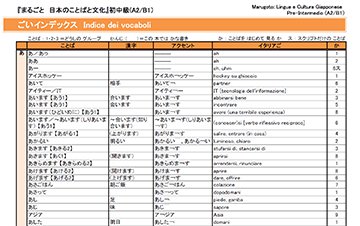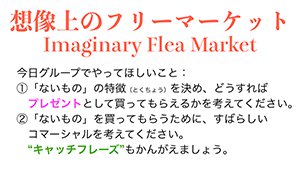Our Activities in 2020
The Japan Cultural Institute in Rome
TSURUTA Yasuyuki
The Japanese-Language Course is Like an Organism
Roughly 200 people study Japanese at the Japanese-language course (hereinafter “JF Course”) run by the Japan Cultural Institute in Rome (hereinafter the “Institute”) each semester, taught by seven part time lecturers and one Japanese-Language Assistant (hereinafter “Assistant”) dispatched from Japan. One of the main jobs of the Japanese-Language Specialist (hereinafter “Specialist”) dispatched to the Institute is the management of the JF Course.
There is much more to managing the JF Course than it looks, involving a wide range of tasks. Those tasks range from those that only a Specialist in Japanese-language education could do to those that might seem possible for someone else to do. For example, advertising for and accepting new students, implementing placement test for students joining mid-course, paperwork for students promoted to the next course level, collecting and handing out texts, reserving online meeting rooms, preparing downloadable documents, reviewing class records, preparing and implementing tests, editing and changing the curriculum, preparing for the next semester, responding to questions from students and third parties, and supporting the part time lecturers. Since there are no full-time administrative staff or full-time lecturers at the Institute to run the JF Course, the Specialist and Assistant must handle that work with the help of other staff members when needed.
I personally see the JF Course as a kind of organism. The administrative bias of the many tasks for managing the JF Course make it seem almost mechanical in nature. However, just like the way a minor ailment occurring in the cells or organs comprising a person can upset their equilibrium, the slightest mistake or lack of forethought can lead to serious problems in the management of the JF Course. And just like a doctor must think of the overall effects on the body when treating an illness, we also must carry out each one of those tasks faithfully with consideration for the JF Course as a whole.
Preparing the “Marugoto” (Downloadable Teaching Materials )
One characteristic of the “Marugoto: Japanese Language and Culture” (hereinafter “Marugoto”) is the abundance of downloadable teaching materials. As to support the local Japanese-language teachers and learners, the offices of the Japan Foundation throughout the world which manage the JF Courses convert the downloadable teaching materials into the local language.
While the work to translate the teaching materials into Italian fell somewhat behind other languages, the translation of the “Vocabulary Index,” which lists the vocabulary used in “Marugoto,” was begun in 2019, and by 2020, we had completed the translation of the starter through pre-intermediate levels. The process of doing so involved the Specialist, myself, making a list of example sentences using the vocabulary taken from “Marugoto,” and then having a Japanese staff member proficient in Italian do a rough translation. That rough translation is then brushed up by the Japanese and Italian staff, and checked by a part-time lecturer from the perspective of using it in class. Finally, the Specialist, Japanese staff, and Italian staff make final adjustments together. The biggest challenge in the translation work was to find the simplest and most accurate words to describe any points that needed a supplementary explanation. Moving forward, we are planning to translate the downloadable materials for “Marugoto” Intermediate 1 into Italian as well.

The Italian Vocabulary Index
Japanese-Language Workshops Featuring Theatrical Approach
In January and February 2020, the Institute hosted online workshops for both Japanese-language teachers and learners featuring theater professionals such as directors and actors. Here, I would like to write a bit about one of those workshops held for Japanese-language learners.
This two-day workshop began with warming up activities on the first day involving Hiragana and rock-paper-scissors, known as Janken in Japanese. The Hiragana activity took advantage of the way meeting participants are arrayed on the screen in Zoom meetings by having them each display one Hiragana character to form words and phrases. We then played variations of the Janken game, such as Atodashi Janken (delayed rock-paper-scissors) and Ryo-te Janken (two hand rock-paper-scissors), that would not be affected by the time delay inherent in Zoom meetings. These activities not only created a fun atmosphere, but they also had the participants warmed up and ready to speak in the subsequent group activities since they had to move their hands and speak out.
We then followed up with a group activity called “Imaginary Flea Market.” To start, we prepared by creating commercials to advertise famous proverbs as “products.” In addition to the learners, two Japanese theater professionals also participated in the activity in order to encourage more active sharing of ideas in the groups, giving rise to more sincere communication between the participants. Each group took advantage of tricks only possible online for their commercials, such as using a Zoom virtual background, toggling the screen back and forth, and incorporating items they had in their respective rooms. We then created Zoom breakout rooms to run a flea market to buy and sell the imaginary products. The participants were split into buyers and sellers and allowed to freely move between the breakout rooms. There they could ask questions and have the products explained, negotiate over bulk prices, and even offer large discounts in the last minutes before closing. The sincerity and realism achieved through the communications in the flea market in this online space was a pleasant surprise to both the lecturers and participants.
The thing that impressed me the most, as a Japanese teacher, was that rather than hesitating when the students were confused or had questions, or when trouble occurred, the teachers instead use those situations as opportunities to steer the communication in new directions. I realized that in my own classes and JF Course management in the past, I have had a tendency to try to anticipate confusion and trouble so that I could take measures to prevent it from happening. However, this workshop taught me from the perspective of communication that I had probably been preventing communication from happening before we had even begun.

An example of workshop activity
- What We Do Top
- Arts and Cultural Exchange [Culture]
- Japanese-Language Education Overseas [Language]
- Japanese-Language Education Overseas [Language] Top
- Learn Japanese-language
- Teach Japanese-language
- Take Japanese-Language Test
- Know about Japanese-language education abroad
- The Japanese-Language Institute, Urawa
- The Japanese-Language Institute, Kansai
- Japanese-Language Programs for Foreign Specified Skilled Worker Candidates
- Japanese Language Education for Japanese Children Resident Overseas and for the Descendants of Migrants
- Archives
- Japanese Studies and Global Partnerships [Dialogue]
- JF digital collection
- Other Programs / Programs to Commemorate Exchange Year
- Awards and Prizes
- Publications
